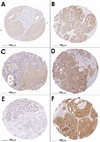Assessment of hepatocyte growth factor in ovarian cancer mortality
- PMID: 21724856
- PMCID: PMC3153603
- DOI: 10.1158/1055-9965.EPI-11-0455
Assessment of hepatocyte growth factor in ovarian cancer mortality
Abstract
Background: Invasive ovarian cancer is a significant cause of gynecologic cancer mortality.
Methods: We examined whether this mortality was associated with inherited variation in approximately 170 candidate genes/regions [993 single-nucleotide polymorphisms (SNPs)] in a multistage analysis based initially on 312 Mayo Clinic cases (172 deaths). Additional analyses used The Cancer Genome Atlas (TCGA; 127 cases, 62 deaths). For the most compelling gene, we immunostained Mayo Clinic tissue microarrays (TMA, 326 cases) and conducted consortium-based SNP replication analysis (2,560 cases, 1,046 deaths).
Results: The strongest initial mortality association was in HGF (hepatocyte growth factor) at rs1800793 (HR = 1.7, 95% CI = 1.3-2.2, P = 2.0 × 10(-5)) and with overall variation in HGF (gene-level test, P = 3.7 × 10(-4)). Analysis of TCGA data revealed consistent associations [e.g., rs5745709 (r(2) = 0.96 with rs1800793): TCGA HR = 2.4, CI = 1.4-4.1, P = 2.2 × 10(-3); Mayo Clinic + TCGA HR = 1.6, CI = 1.3-1.9, P = 7.0 × 10(-5)] and suggested genotype correlation with reduced HGF mRNA levels (P = 0.01). In Mayo Clinic TMAs, protein levels of HGF, its receptor MET (C-MET), and phospho-MET were not associated with genotype and did not serve as an intermediate phenotype; however, phospho-MET was associated with reduced mortality (P = 0.01) likely due to higher expression in early-stage disease. In eight additional ovarian cancer case series, HGF rs5745709 was not associated with mortality (HR = 1.0, CI = 0.9-1.1, P = 0.87).
Conclusions: We conclude that although HGF signaling is critical to migration, invasion, and apoptosis, it is unlikely that HGF genetic variation plays a major role in ovarian cancer mortality. Furthermore, any minor role is not related to genetically-determined expression.
Impact: Our study shows the utility of multiple data types and multiple data sets in observational studies.
©2011 AACR.
Figures



References
-
- Jemal A, Siegel R, Xu J, Ward E. Cancer statistics, 2010. CA Cancer J Clin. 2010;60:277–300. - PubMed
-
- Hoskins WJ, Bundy BN, Thigpen JT, Omura GA. The influence of cytoreductive surgery on recurrence-free interval and survival in small-volume stage III epithelial ovarian cancer: a Gynecologic Oncology Group study. Gynecol Oncol. 1992;47:159–166. - PubMed
-
- McGuire V, Jesser CA, Whittemore AS. Survival among U.S. women with invasive epithelial ovarian cancer. Gynecol Oncol. 2002;84:399–403. - PubMed
-
- Tan DS, Rothermundt C, Thomas K, Bancroft E, Eeles R, Shanley S, et al. "BRCAness" syndrome in ovarian cancer: a case-control study describing the clinical features and outcome of patients with epithelial ovarian cancer associated with BRCA1 and BRCA2 mutations. J Clin Oncol. 2008;26:5530–5536. - PubMed
Publication types
MeSH terms
Substances
Grants and funding
LinkOut - more resources
Full Text Sources
Medical
Miscellaneous

